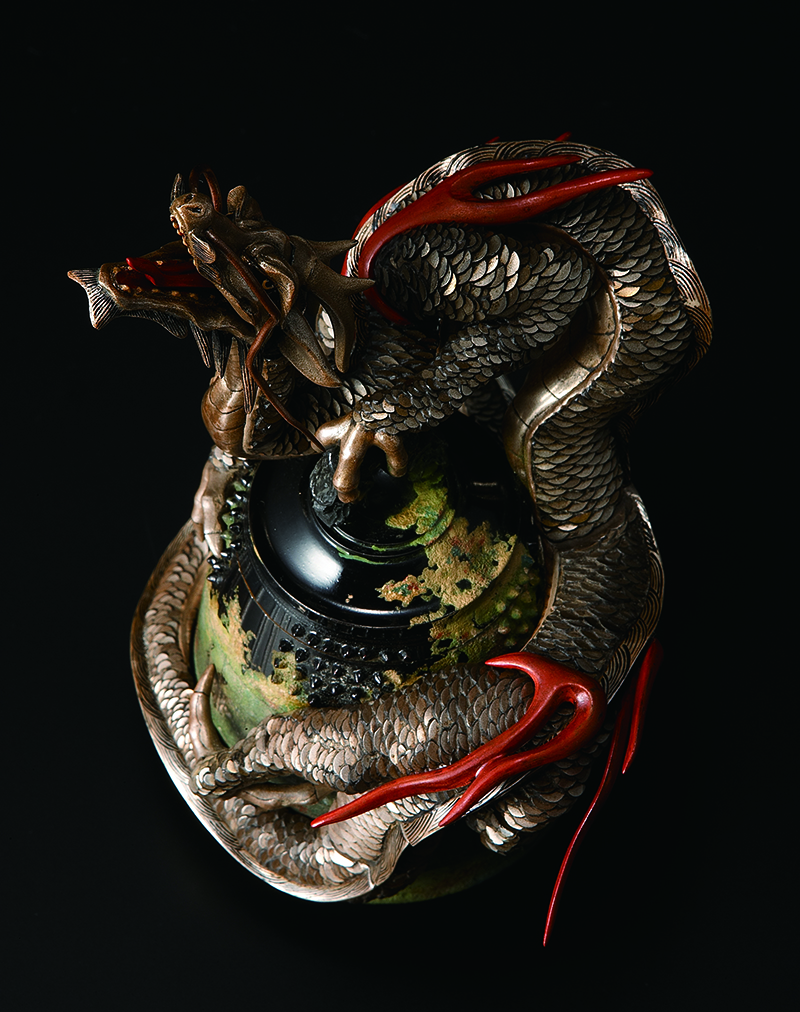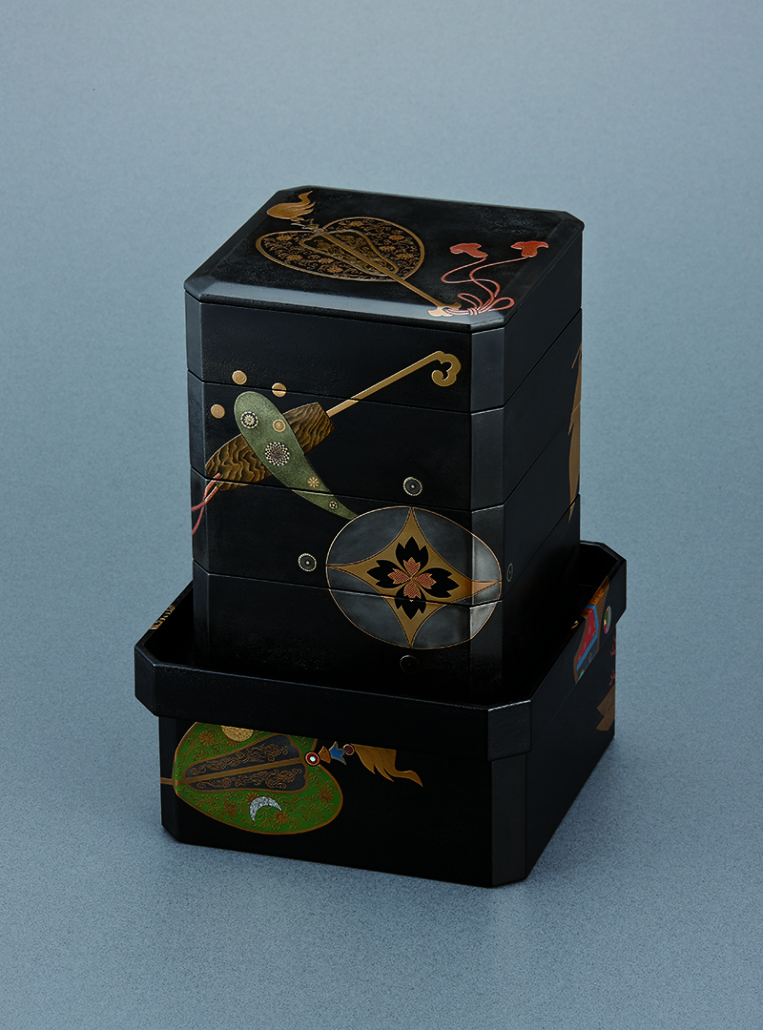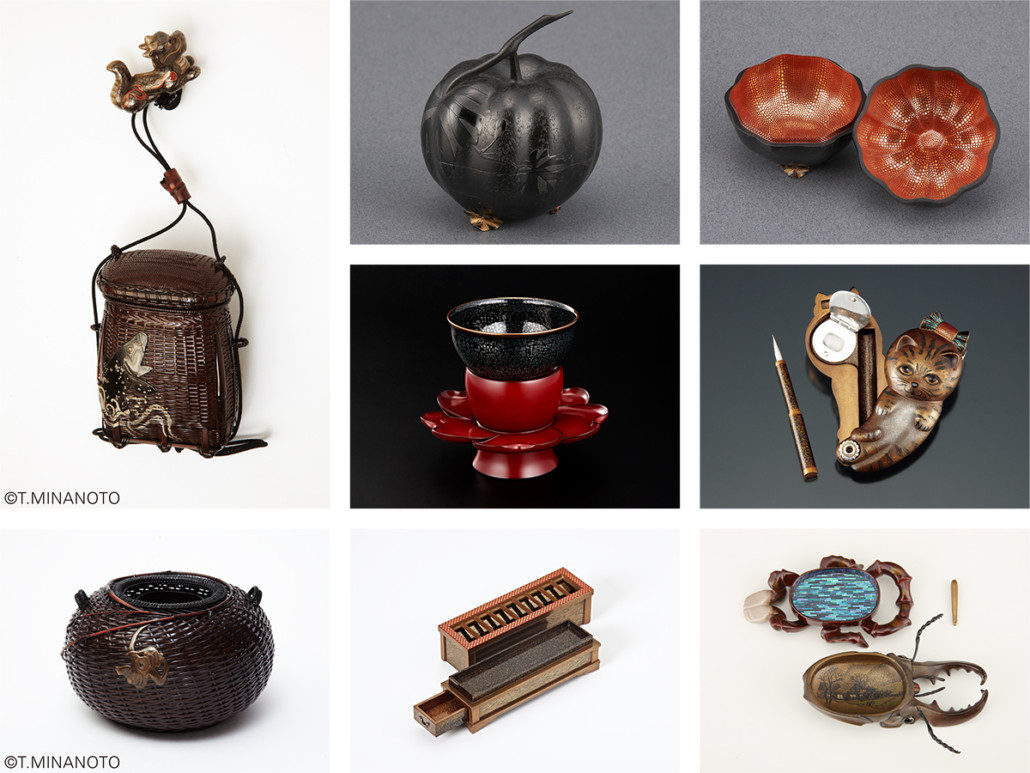HIKOJU MAKIE
the artist group of Japanese lacquerware
漆芸集団「彦十蒔絵」
“HIKOJU MAKIE” is an artist group of Japanese lacquerware based in Wajima, Ishikawa prefecture. They have produced unique lacquerware known as “Urushi” through reinterpretation of joking and humor developed in the Edo period, and received high praise not only in Japan but also overseas. Their works are created by twenty craftsmen including Kijishi (woodworker), Nushi (lacquer painter) and Nurishi (lacquer-painting craftsmen) under the plan of Takashi Wakamiya, the group’s leader. Wakamiya, born in 1964, learned technique of Makie (lacquer sprinkled with gold or silver powder) and the basics of lacquerwares in Wajima. He founded “Wajima folk craft furniture (Wamin)” in 1994. Since 2001 the exhibitions of his works at museums in Europe and department stores in Japan have earned good reputation, and the works have been stored and displayed in Museum fur Lackkunst in Germany and Victoria and Albert Museum in the UK. He was designated as The Agency for Cultural Affairs in 2014.
Wajima-nuri (Wajima lacquerware) gained the top share in the Japanese mass‐produced goods market such as nest of boxes, bowls and furniture in Showa period (1926-1989). However, the demand for them decreased after burst of Japan’s economic bubble (1991). Wakamiya, at the age of 35, founded “HIKOJU MAKIE” with a few craftsmen, fearing that many craftsmen quit their job one after another during the period. He keeps pace with the current of the times with a new attempt which is regarded as heterodoxy in Wajima. He was inspired by the fact that Japanese lacquer craft works, gone out to foreign countries in Meiji Period, received a high evaluation in Western countries where interior design and art culture had highly developed, and he created bronze coating looks like bronze craft. HIKOJU MAKIE creates new lacquerware which was formerly the symbol of dignity and power, and sends information about their products as three-dimensional works with humorous, stylish wittiness. Their works have been stored in museums in Europe and collectors’ houses at the exhibitions of department stores in Japan, and they got a new market.
In modern Japan, the society gives top priority to economics and many people feel stressed although they live in an era of peace. The traditional elegant culture such as Chanoyu (Japanese tea ceremony) and Ikebana (Japanese art of flower arrangement) realized Zen is becoming formal action at the present day. Japanese craftsmanship, filled with self-actualization and helpful spirit, is applicable to Zen. Wakamiya pursues the way lacquerware existences in Japanese culture and aims to make people happy through craftsmanship. He became a producer by himself and began with improving craftsmen’s consciousness. Nowadays HIKOJU MAKIE has ambitiously released collaboration works created with bamboo craftsmen, woodcarvers, craftsmen sticking gold leaf and ceramic artists who succeed at home and abroad, based on the tradition of Wajima lacquerware. Some delicate craftsmanship transmitted to posterity for hundreds of years is deeply mixed together and creates harmonization of crafts. Their works will change the traditional values of the production areas by and by.
石川県輪島市にある漆芸集団「彦十蒔絵」は、江戸時代に発達した洒落やユーモアを新解釈した漆作品を発信し、国内外で高い評価を受けている。制作は、棟梁の若宮隆志の構想をもとに、二十人を数える木地師や塗師、蒔絵師によって仕上げられる。若宮は輪島市に生まれ、輪島塗の蒔絵技法、漆芸の基礎を学んだ。1994年に輪島民芸家具(輪民)を立ち上げ、2001より欧州の美術館や日本の百貨店での展示が好評を得て、作品がドイツMuseum of Lacquer Art Münster、イギリスVictoria and Albert Museumなどに収蔵される。2014年文化庁文化交流使に指名される。
輪島塗は、昭和時代は重箱、お椀、家具を中心とした量産品で国内市場のトップシェアを誇ったが、バブル崩壊後、需要が低減し、職人たちが次々と辞めていったことを危惧して、若宮は35歳で2,3人の職人と「彦十蒔絵」を興す。輪島では異端ともいえる新しい試みで、時代の変化に対応する。若宮は明治時代に海外に出た日本の漆芸品が、インテリアや愛玩用の文化が発達した西洋で高く評価されたことに触発され、青銅に見立てた青銅塗を開発。日本では威厳、権力の象徴だった漆を、ユーモラスあふれるしゃれと粋を持った立体作品として発信。日本の百貨店での展示会で欧州の美術館やコレクターに収蔵され、若宮も積極的に海外へ発信し、新たな販路を得た。
現代の日本は経済が最優先され、平和な時代にもかかわらず、ストレスを抱える人が多く、禅を具現化したお茶や花など雅な文化も形式的になりつつある。自己実現と人の役に立つ精神性を持った日本の職人魂も禅に通じる。若宮は日本文化の中にある漆器のあり方を突き詰め、ものづくりを通して人々を幸せにすることを目指した。自らプロデューサーとなり、職人たちの意識改革からはじめた。今では「彦十蒔絵」は輪島塗の伝統をベースに、国内外で活躍する竹工芸、木彫、金箔、陶芸作家と積極的にコラボレーション作品を発表し続けている。数百年も積み重ねてきた緻密な職人技が深くかみ合い、「融合する工芸」を創り出し、やがて産地の価値を変えていく。


